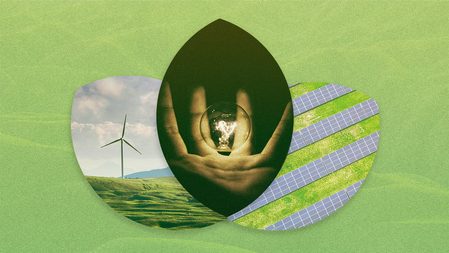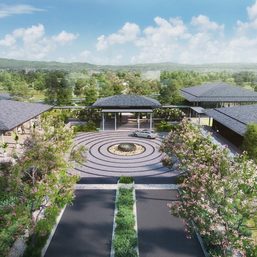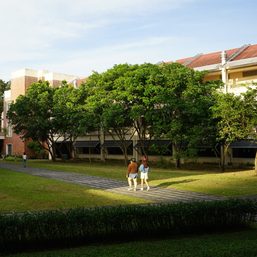SUMMARY
This is AI generated summarization, which may have errors. For context, always refer to the full article.

MANILA, Philippines – Fisherfolk in Laguna are demanding inclusion in the large-scale floating solar project in Laguna de Bay.
Through a consultation with nonprofit organizations, fisherfolk leaders of the Fisheries and Aquatic Resource Management Councils (FARMC) of Biñan, Sta. Rosa, Calamba, and Bay in Laguna came up with an agenda that calls for just energy transition.
They want fisherfolk to be involved in the process, from construction to decommissioning of the solar project. They also want to be able to decide where the solar blocks should be, as it affects navigational lanes, fish pens, and cages.
Fisherfolk are demanding that they be given leeway to check that materials used in panel blocks will not harm the environment and will endanger communities when storms hit.
“Dala-dala namin ang adbokasiya ng just energy transition o ang pagbabago patungo sa mga mas sustenable at maka-kalikasan na mga pamamaraan, teknolohiya, at proseso, kung saan lahat ay kasama at walang maiiwan,” the document read.
(We bear the advocacy of just energy transition, or the change towards a more sustainable and pro-environment process and technology where everybody is included and no one is left behind.)
Fisherfolk also want concerned developers to initiate quarterly lake seeding as well as water sampling and cleaning activities at the lake.
The consultation was conducted last March by nonprofit Reboot Philippines Renewable Energy Transition Institute (RebootPH), together with policy think tank Legal Rights and Natural Resources Center (LRC) and Oxfam Pilipinas.
Allein Espinoza of RebootPH said that all FARMCs in each Laguna town should have a memorandum of agreement with the developers granting this agenda.
According to Espinoza, their group has been working with Laguna fishers since November 2023.
“Kung may kahit isa na munisipyo na ‘di mabigyan, walang endorsement,” said Espinoza. (If there’s just one municipality not granted an MOA, there will be no endorsement.)
Another fisherfolk group, Pamalakaya-Bay, and members of the Save Laguna Lake Movement held a dialogue with the Laguna Lake Development Authority on Wednesday, July 3. Pamalakaya-Bay opposed the project, saying it threatens the livelihood of over 800 fisherfolks.
How big is the project?
The floating solar project in Laguna de Bay covers 2,000 hectares.
There are three developers involved: Sun Asia, Singapore-based Vena Energy, and Ayala-led ACEN.
Sun Asia covers 1,000 hectares; Vena Energy, 200 hectares; and ACEN, 800 hectares. The project is expected to add around 1,000 megawatts to ACEN’s portfolio.
The consultation in March included towns that the Sun Asia project will cover. Espinosa said that Laguna de Bay should be seen as a whole ecosystem when checking the projects’ impacts.
“The framework of the consultation is Laguna-wide and ecosystems-based, treating the lake as a whole, that’s why even those municipalities in Laguna without solar should be included because they could possibly be affected,” Espinoza said in a mix of Filipino and English.
Laguna de Bay is the largest lake in the Philippines. It spans 900 square kilometers, bounded by Rizal and Laguna, and towns and cities in Batangas, Cavite, Quezon, and Metro Manila.

How can energy transition be just?
Concerns over the potential negative impact of renewable energy projects mount as the Philippines, and the rest of the world, speeds up transition.
While the transition to renewable energy is needed to limit global warming and reduce greenhouse gas emissions, advocates caution against the harm brought by mining of minerals used for renewable energy, as well as potential human and labor abuses.
“We need to be careful in terms of what we allow,” LRC advocacy coordinator Maya Quirino said in a forum on June 25.
In a study launched on June 25, LRC pointed out the SunAsia’s floating solar farm was the first to get a certification after President Ferdinand Marcos issued Executive Order 18 on constituting green lanes for strategic investments.
“A transition away from fossil fuel-reliant industries is only as laudable as the efforts made to ensure that workers and communities still have livelihoods and means to sustain their lives after we shift to a fully renewable energy-reliant world,” the study read.
In the Philippine Energy Plan, the national government aims to increase renewable sources at 35% in the energy mix by 2030, then 50% by 2040.
– Rappler.com
Add a comment
How does this make you feel?







![[OPINION] Could the low-carbon economy bill re-write the Philippines’ future?](https://www.rappler.com/tachyon/2024/06/tl-decarbonization.jpg?resize=257%2C257&crop=137px%2C0px%2C360px%2C360px)

![[In This Economy] Why we need to stop the proposed Laguna de Bay expressway](https://www.rappler.com/tachyon/2024/06/Why-we-need-to-stop-Laguna-de-bay-expressway-June-28-2024.jpg?resize=257%2C257&crop=458px%2C0px%2C720px%2C720px)



![[OPINION] Clear timelines needed for phaseout of fossil fuels](https://www.rappler.com/tachyon/2024/06/tl-fossil-fuel-phaseout.png?resize=257%2C257&crop_strategy=attention)

There are no comments yet. Add your comment to start the conversation.